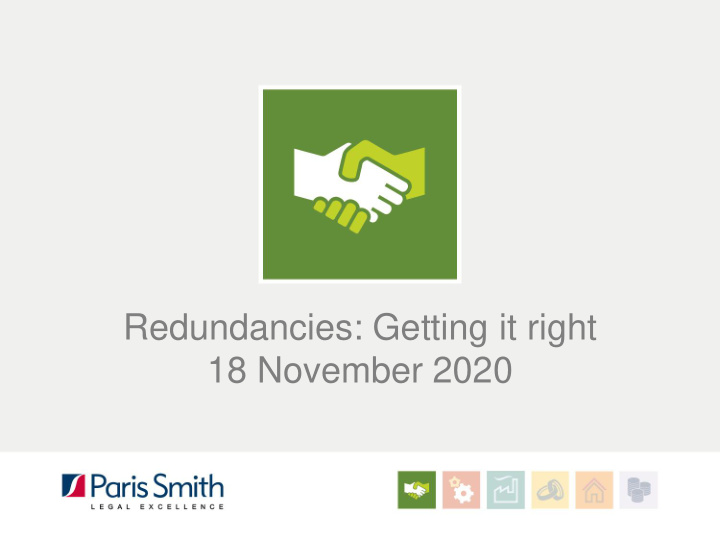



Redundancies: Getting it right 18 November 2020
Redundancy situation • Most common- diminished need for employees to do work of a particular kind • Diminished level of work is to be judged by employer – commercial judgment/priorities of the business • Employees with over 2 years’ service protected from unfair dismissal
Collective/Individual consultation • If 20 or more dismissals proposed = collective and individual consultation • Obligation to notify the Secretary of State • Period consultation must begin before first dismissal takes effect o 30 days for 20-99 dismissals o 45 days for 100 + dismissals • Less than 20 = individual consultation only
Redundancy flowchart Step 1 Establish a genuine redundancy situation Consider pool and selection criteria and Step 2 any alternative vacancies Elect representatives & notify Sec of State Step 3 (if collective consultation applies) Start collective consultation Step 4 (if more than 20 redundancy dismissals)
Redundancy flowchart Step 5 First at risk letter & individual meeting Step 6 Scoring process Individual consultation process Step 7 (including search for alternative vacancies) Step 8 Dismissals and appeal
Selecting employees • Roles at risk, not people • What work is reducing and who does that work? • Consider if voluntary redundancies could assist
Choosing the selection pool • Employer has flexibility • Is the pool within the range of reasonable responses? • Consider: • What type of work is ceasing or diminishing? • Which employees are doing similar work? • Are employees’ jobs are interchangeable?
Selection criteria • Should be objective, verifiable and reasonable • Examples: • Performance against targets • Communication with customers • Disciplinary record • Attendance (but watch disability) • Qualifications and training • Be wary of potentially discriminatory criteria
Selection criteria Consider: • Use a scoring matrix/assessment form • Give clear guidance to managers as to how employees should be scored • If and how you will mix of evidence based and more subjective criteria
Individual consultation First letter – First Consultation At risk meeting Scoring process Meeting At risk If applicable, deal Third letter – Second with applications follow up second Second letter – Consultation for alternative meeting and invite scores and invite to Meeting employment to final meeting Fourth letter – Final Consultation confirmation of Appeal process meeting – dismissal dismissal and right of appeal
Key points of consultation • Plan in advance but be adaptable • Educate and train managers to conduct meetings • Consider redundancy situation now and in the future • Include absent employees • Genuine consultation
The impact of COVID 19
Alternatives to redundancy • A cut in pay (keeping hours the same) • A cut in hours with associated reduction in pay • Job share • Sabbaticals/career breaks • Re-training • Job Support Scheme/Furlough under the CJRS
Altered process • Skype or zoom video calls • More time to enable employees to prepare • Pay extra attention to communication • Don’t be tempted to do everything in group meetings • Make sure employees know how to contact you if they are not in the office
Additional risks • Employees more likely to challenge their selection over their colleagues • Employees more likely to challenge the redundancy situation itself • Heightened emotions • Higher compensatory award due to job market
Questions?
FAQs • Does an employee have a right to see other employees’ scores? • Should you consult over the selection criteria? • Do you have to offer voluntary redundancy? • Do you have to consider bumping?
FAQs • Do you have to honour an employee’s current salary if you offer them a more junior role? • Do you have to look for vacancies within other group companies? • Do you have to allow employees time off to look for another job if they are redundant?
FAQs • Can we make employees on furlough or the Job Support Scheme redundant? • If business picks up how long do we have to wait before we can re-advertise for roles? • When do you have to count voluntary redundancies in numbers for collective consultation?
FAQs • Can we use competitive interviews rather than selection criteria? • Can we make people apply for their existing jobs? • Can you make an employee who’s pregnant or on maternity leave redundant?
David Roath T: 07793625 900 E: david.roath@parissmith.co.uk Tabytha Cunningham T: 07384258461 E: er@parissmith.co.uk
Recommend
More recommend